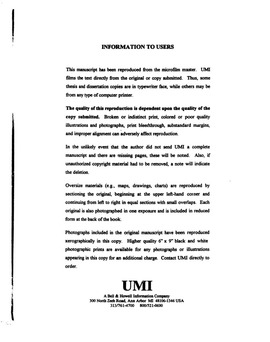| dc.contributor.advisor | Prieto, Loreto, | en_US |
| dc.contributor.author | Berryhill, Elise Michele. | en_US |
| dc.date.accessioned | 2013-08-16T12:29:57Z | |
| dc.date.available | 2013-08-16T12:29:57Z | |
| dc.date.issued | 1997 | en_US |
| dc.identifier.uri | https://hdl.handle.net/11244/5589 | |
| dc.description.abstract | Many social science disciplines have examined the process of socio-cultural change that takes place among ethnic minority persons living in a culturally different environment. While the focus of these studies have been on the changes that occur at a group level, it has been relatively recently that the phenomenon known as acculturation has been investigated at an individual level. Instead of focusing on group adaptations, the individual's behavioral, social, cognitive, and emotional responses to this dynamic process have been the focus of psychological research. The purpose of this study was to investigate the psychometric properties of the Life Perspectives Scale-Form B (LPS-B) which was based on the theory of American Indian acculturation proposed by Choney, Berryhill-Paapke, and Robbins (1995). Specifically, data was collected to determine if the LPS-B reflected the four domains (social, cognitive, affective, and behavioral) of their acculturation theory. | en_US |
| dc.description.abstract | One hundred sixty-nine American Indian participants from 22 different tribes were solicited from the state of Oklahoma. The participants were patients from the Oklahoma City, Eufaula, Okmulgee, and Sapulpa Indian Health clinics. Participants ranged from 16 to 84 years of age. Instruments included a consent form, demographics questionnaire, and the LPS-B. Descriptive statistics, analyses of variance, a principal components analysis, and additional factor analyses with varimax and oblique rotations were performed on the data. Significant socio-cultural indicators of Indian cultural identity included speaking one's traditional language, being raised and living around other Indian people, attending tribal gatherings, possessing higher blood quantum, and acknowledging a commitment to tribal culture. The results of the factor analyses indicated that the items on the LPS-B best support a 2 factor structure, and that this factor structure does not reflect the domains present in the theory of acculturation for American Indians proposed by Choney et al. (1995). Recommendations for future development of an American Indian acculturation scale are provided based on the findings. | en_US |
| dc.format.extent | ix, 191 leaves ; | en_US |
| dc.subject | Sociology, Ethnic and Racial Studies. | en_US |
| dc.subject | Acculturation. | en_US |
| dc.subject | Psychology, Psychometrics. | en_US |
| dc.subject | Indians of North America Cultural assimilation. | en_US |
| dc.subject | Psychology, Clinical. | en_US |
| dc.title | Examining the Life Perspective Scale: An investigation of an American Indian acculturation instrument. | en_US |
| dc.type | Thesis | en_US |
| dc.thesis.degree | Ph.D. | en_US |
| dc.thesis.degreeDiscipline | Department of Educational Psychology | en_US |
| dc.note | Source: Dissertation Abstracts International, Volume: 58-12, Section: B, page: 6800. | en_US |
| dc.note | Adviser: Loreto Prieto. | en_US |
| ou.identifier | (UMI)AAI9817721 | en_US |
| ou.group | Jeannine Rainbolt College of Education::Department of Educational Psychology | |
